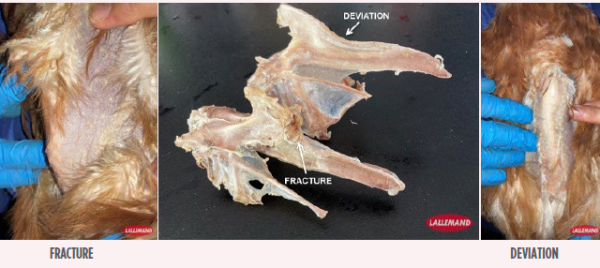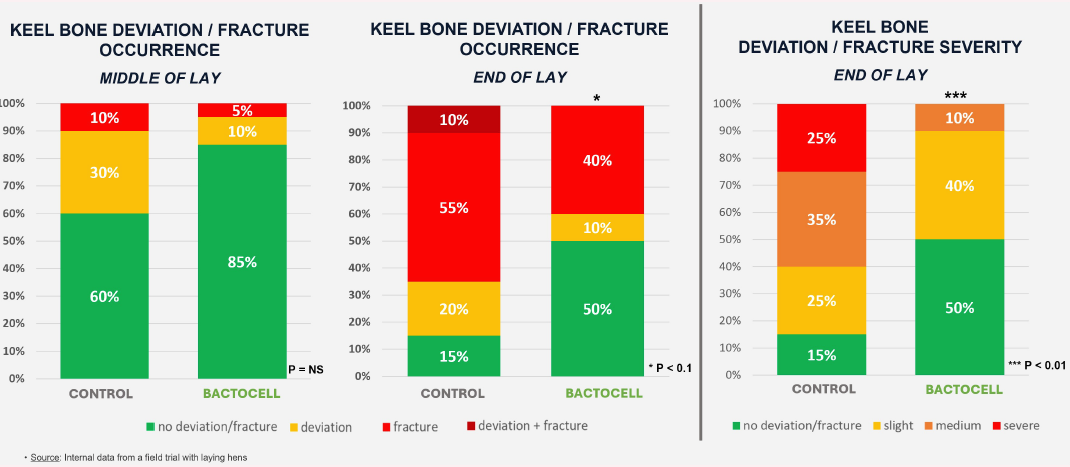
A NEW WAY TO ASSESS BACTOCELL BENEFITS ON LAYING PERFORMANCE AND EGG QUALITY
Nowadays, modern genetics are highly efficient, with hens producing up to 500 eggs per cycle. Nevertheless, this high laying productivity, with extended laying cycles (up to 100 weeks of age), induces an increase of calcium (Ca) requirements that can negatively impact keel bone health.
As highlighted in recent scientific studies, keel bone damages can result in significant welfare challenges for layers. Up to 90% of laying hens housed in aviary systems are affected by keel bone fractures, which are likely to cause pain and suffering.
Due to its anatomical position, keel bone is prone to deformities, especially in modern birds. Keel bone damages comprises both (Figure 1):

Figure 1 – Examples of keel bone deviation and keel bone fracture (©Lallemand).
Ensuring good skeletal development and managing Ca metabolism during the laying period are thus crucial to sustain both hen welfare and economic performance.
Furthermore, muscle development and protein retention are key in maintaining the persistency of the laying curve. Pectoralis muscle development and keel bone integrity are therefore key predictors of laying performance and persistency.
This new approach allows to objectively demonstrate the benefits of a probiotic, Pediococcus acidilactici CNCM I-4622 (BACTOCELL), on these parameters while supporting welfare.
The use of this probiotic dedicated to monogastric animals has been extensively documented for the last 25 years, with more than 100 scientific publications. This lactic acid bacteria was specifically selected for its ability to exclusively produce high levels of L-lactic acid (a source of energy for the birds).
ASSESSING PECTORALIS MUSCLE DEVELOPMENT
Pectoralis muscle palpation is generally recommended by genetic guidelines to predict good laying curve persistency: the better the pectoralis muscle scoring, the more the layer will be able to sustain high egg production.
Although easy, hand palpation is highly subjective and operator dependent, based on their expertise and training level. A standardized protocol using an ultrasonography device was developed to record pectoralis muscle thickness of birds, directly on farm (Figures 2 and 3).
Figure 2. Application of ultrasonography device on top of the keel bone, perpendicular to the (major and minor) pectoralis muscle, to precisely measure its thickness, and to assess keel bone integrity and morphology by sliding the device along the length of the bone to get a complete picture (©Lallemand).
Figure 3. Pectoralis muscle thickness in a well-muscled hen (left: thicker) and in a poorly muscular hen (right: thinner) obtained by ultrasonography. The keel bone is barely detected by palpation in well-muscled hens (left) whereas it is protruding in poorly muscular hens (right) (©Lallemand).
However, some limits have been highlighted relating to the use of the ultrasonography device. Alternative and complementary methodologies have thus been investigated by Lallemand to predict pectoralis muscle thickness of both pullets and layers based on easy-to-collect field data. A prediction equation was established using the following indicators:
These non-invasive methods can be used to validate the beneficial effect of Pediococcus acidilactici CNCM I-4622 (BACTOCELL) on muscle development. Consistent results showing a significant increase of pectoralis muscle thickness were observed when supplementing different poultry species (pullets, layers, broilers) with BACTOCELL over different periods of time (Table 1).
Table 1 – Improvement of pectoralis muscle development following BACTOCELL supplementation in different poultry trials.
Hand palpation can display a poor diagnostic accuracy in detecting keel bone fractures, meaning invasive methods, like necropsy, must be applied in conjunction for reliable assessment.
A standardized protocol using ultrasonography was developed by Lallemand to assess keel bone integrity by investigating deviations and/or fractures presence and severity, directly on farm (Figure 4). Ultrasonography appears to be thus a valuable complementary tool which can also be confirmed by X-ray observation.
Figure 4. Keel bone fractures: light (a), severe (b and c) and a bone callus in the early stages of formation (d) observed with ultrasonography (©Lallemand).
As highlighted by different academic and field trials, laying hens supplemented with BACTOCELL did display a significant reduction of keel bone deviation or fracture. In a recent large scale trial, layers supplemented with BACTOCELL showed fewer keel bone deviations (10% vs 20% in control group) and keel bone fractures (40% vs 55% in control group) at the late stage of the laying cycle.
Moreover, more intact keel bones were observed in the BACTOCELL group (50% vs 15% in control group). Some laying hens presented both keel bone deviation and fracture (10%), but all of them were in the control group. When some keel bone deviations and/or fractures were observed, their severity was reduced in the probiotic-supplemented group (Figure 5).
These recent data support previous observations of greater bone resistance and more efficient mineralization process (Ca, P, osteocalcin and calcitriol blood concentrations) associated with improved keel bone morphology and integrity in hens supplemented with BACTOCELL.

Figure 5. Evolution of keel bone integrity in layers supplemented with BACTOCELL throughout the laying cycle (field trial in a commercial farm of 40,000 hens, 2024).
Using non-invasive methods to evaluate pectoralis muscle development and bone mineralization can prevent invasive measurements involving the death of birds, especially in the current context of extending hen life cycles for economic, societal and environmental concerns.
Both ultrasonography and new cost-effective methods based on easy-to-measure indicators can be considered as valuable diagnostic tools to predict laying performance and egg quality while supporting animal welfare.
These methods can be included in protocols routinely used to objectively demonstrate the benefits of the probiotic Pediococcus acidilactici CNCM I-4622 (BACTOCELL) on body composition, muscle and bone development, proving BACTOCELL to be a valuable nutritional strategy to safeguard laying performance and egg quality (Figure 6).
Subscribe now to the poultry technical magazine
AUTHORS

Layer Longevity Starts at Rearing
H&N Technical Team
The Strategy for a Proper Infectious Bronchitis Control
Ceva Technical Team
Elevate Hatchery Performance with Petersime’s New Data-Driven Incubation Support Service
Petersime Technical Team
Maize and Soybean Meal Demand and Supply Situation in Indian Poultry Industry
Ricky Thaper
Production of Formed Injected Smoked Chicken Ham
Leonardo Ortiz Escoto
Antimicrobial Resistance in the Poultry Food Chain and Novel Strategies of Bacterial Control
Edgar O. Oviedo-Rondón
GREG TYLER INTERVIEW
Greg Tyler
Insights from the Inaugural US-RSPE Framework Report
Elena Myhre
Newcastle Disease: Knowing the Virus Better to Make the Best Control Decisions. Part II
Eliana Icochea D’Arrigo
Avian Pathogenic E. coli (APEC): Serotypes and Virulence
Cecilia Rosario Cortés
The Importance of Staff Training on Animal Welfare Issues in Poultry Industry
M. Verónica Jiménez Grez
Rodent Control is a Key Factor in Poultry Biosecurity and Sustainability
Edgar O. Oviedo-Rondón